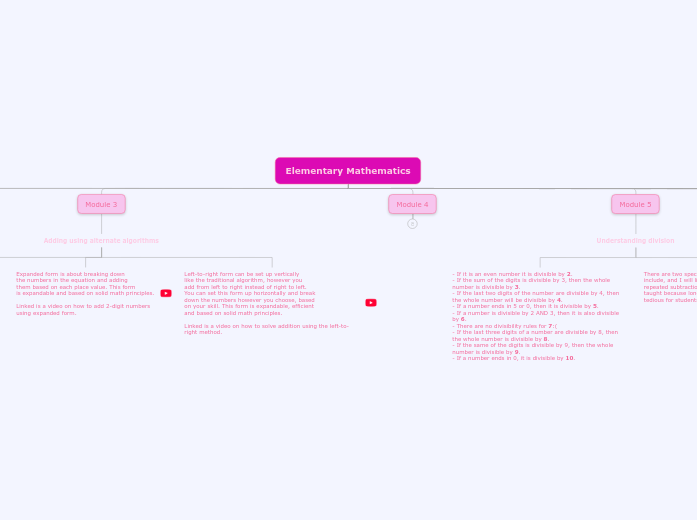Elementary Mathematics
Module 1
Problem solving strategies
UnDevCarLo:
Step 1- Understand the problem
Step 2- Develop a plan
Step 3- Carry out the plan
Step 4- Look back to see if the answer makes sense
Possible methods to solve:
-Guess/check
-Diagrams
-Lists
-Algorithms
Module 2
Building addition (Base 10 blocks)
Base 10 blocks are a type of manipulative
students can use to visually represent numbers
A "single" refers to a small square and represents
single digits. A "long" refers to a long rectangle and
represents ten's places. (There are 10 singles in a long)
A "flat" refers to a big square and represents the 100's
place.
Showing addition
When it comes to showing addition students will draw diagrams of base 10 blocks in order to help them solve
addition problems.
Linked is a video on how to add using diagrams of these blocks.
Module 3
Adding using alternate algorithms
The traditional algorithm is the most
common algorithm used for solving addition.
It is expandable and efficient, however it is
not based on solid math principles. As a teacher
you should begin by showing your students the
expanded, and left-to-right form because these
algorithms are based on solid math, and it breaks
down the equation so that the student fully
understands what he or she is solving. Once your
students have become affluent in addition, they
should use the traditional algorithm because it is
the most efficient.
Expanded form is about breaking down
the numbers in the equation and adding
them based on each place value. This form
is expandable and based on solid math principles.
Linked is a video on how to add 2-digit numbers
using expanded form.
Left-to-right form can be set up vertically
like the traditional algorithm, however you
add from left to right instead of right to left.
You can set this form up horizontally and break
down the numbers however you choose, based
on your skill. This form is expandable, efficient
and based on solid math principles.
Linked is a video on how to solve addition using the left-to-right method.
Module 4
Module 5
Understanding division
- If it is an even number it is divisible by 2.
- If the sum of the digits is divisible by 3, then the whole number is divisible by 3.
- If the last two digits of the number are divisible by 4, then the whole number will be divisible by 4.
- If a number ends in 5 or 0, then it is divisible by 5.
- If a number is divisible by 2 AND 3, then it is also divisible by 6.
- There are no divisibility rules for 7:(
- If the last three digits of a number are divisible by 8, then the whole number is divisible by 8.
- If the same of the digits is divisible by 9, then the whole number is divisible by 9.
- If a number ends in 0, it is divisible by 10.
There are two specific algorithms for division I would like to include, and I will link videos for both of them. They are repeated subtraction and area model. These algorithms are taught because long division can be very confusing and tedious for students.
